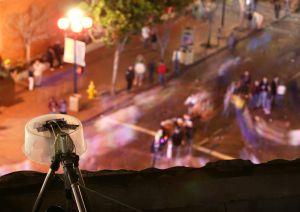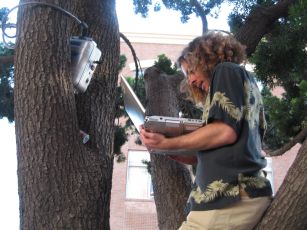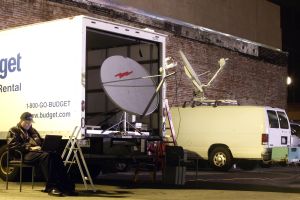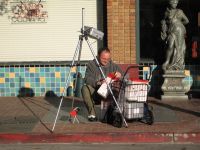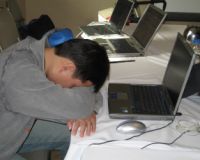Calit2 Researchers Deploy Communications Network at San Diego Mardi Gras Festivities
|
San Diego, CA, March 9, 2006 -- More than two dozen Calit2 researchers deployed a mobile communications and sensor network infrastructure to support the Gaslamp Quarter Association and the San Diego Police Department's (SDPD) management of the immensely popular Mardi Gras event on February 28.
The annual festivities draw thousands of participants to the Gaslamp Quarter in downtown San Diego for an extended evening of revelry: live bands, a parade, extravagant costumes, beads, beads and more beads. The event is supposed to be wild, but not out of control or dangerous. Incident management is critical for such events where law enforcement must know what is developing, whether behavioral characteristics are changing, and then be able to respond appropriately. Responders cannot be everywhere at once, and tight constraints on funding and staffing make it even more necessary to make the best use of available resources.
Nearly 30 Calit2 personnel were involved in this effort; the majority were researchers from the Responding to Crises and Unexpected Events (RESCUE) and ResponSphere projects at Calit2. A few members of the team were from San Diego State University (SDSU). The mission of the RESCUE and ResponSphere projects is to transform the ability of public safety personnel and first responders to gather, manage, use, and disseminate information during emergencies and public crises, situations for which there is no lead time and the standard communications systems and infrastructure may be unusable or unreliable. To support the law enforcement teams covering Mardi Gras, researchers designed, built, and installed a communications and sensor network to cover the approximately three-by-eight square block area downtown from 4th Street to 6th Street, west to east and E Street to L Street, north to south.
|
RESCUE and ResponSphere personnel had previously participated in numerous disaster drills, which are choreographed to emulate live emergency situations. But according to Ramesh Rao, Calit2 UCSD director, Mardi Gras "was a step forward towards the more chaotic environment seen in real emergencies and disasters." The Mardi Gras deployment gave the researchers an opportunity to test their technologies and products in real time, under field conditions and importantly, to assess their performance and usefulness when integrated together.
"The team successfully integrated different access technologies and networks to create a single, more reliable network," notes Babak Jafarian, Calit2 senior development engineer. A core group of a dozen or so researchers from several subprojects, made this work. They integrated systems in the lab which had been developed and built separately, then again integrated them in the field (resolving many newly revealed issues).
|
"Various subsystems were deployed and made to interoperate to produce a cohesive whole in a very short period of time," says Ganapathy (Ganz) Chockalingam, Calit2 principal development engineer. Indeed, the successful integration of so many systems was all the more remarkable given that researchers only had six weeks to prepare for the event. But it was an intense six weeks of building, testing, adapting, re-testing, fine tuning, and testing again.
The foundation of the infrastructure was a wireless network system connecting sensors and access points to each other and to the Internet, as well as streaming data back to the SDPD command post and the UCSD Technology Operations Center. The infrastructure consisted of a CalMesh network, Tropos wireless access points, satellite dish deployment and Mushroom Networks. The CalMesh and Mushroom Networks were designed and developed at Calit2. Sky River provided the backhaul (connection to the Internet).
Multiple applications were deployed, including a video stream over a cell phone system, location-based tracking, cameras over a virtual private network (which included two cameras streaming video into the SDPD command post), and "call-to-collaborate" -- a system for relaying information and instructions en masse via cell phone.
|
The installation of this mobile infrastructure, most of which was taken back down within a few hours of the end of Mardi Gras, produced significantly important research data and other information that would not have been discovered otherwise. For example, when you are far away and want to increase your coverage area, unexpected interference with the signal was found when the location was changed, up to the second floor. "This was the real world converging with research, prototyping, developing and improving tools, what works, what does not, what can we make better, quicker, clearer, and what new areas do we need to pursue," explains Calit2's Rao, who is also a principal investigator on the RESCUE project and a co-principal investigator on the ResponSphere project.
From the Tech Ops Center, located inside the event perimeter at a hotel near the southern end of the covered area, team members monitored the wireless mesh and sensors and ensured that they were working properly. They also collected network and sensor data for future study and evaluation. Research included TEMS measurements, microphone/video array in the operations center for situational awareness data, spectrum analyzer measurements, and network performance measurements (e.g., management, load, packet loss). "The Mardi Gras installation provided a sample large-scale platform for studying the efficacy of the research products developed under RESCUE and it revealed new directions for research," says Calit2 postdoctoral researcher B.S. Manoj.
Several representatives of the San Diego Police Department came over from their command post to visit the UCSD Tech Ops Center, including San Diego Police Chief William Lansdowne, as well as Sergeant Philip Terhaar and Officer Lance Dorman, both of the SDPD Critical Incident Management Unit (CIMU). They were given a demonstration of the technologies deployed and each was explained including available capabilities not in use at the time. They expressed interest in the potential of the various technologies and in possibly working together in the future, perhaps on a testbed.
From the research point of view, the deployment was very successful, with many researchers feeling that their expectations had not only been met, but exceeded. A large amount of significant research data was collected by all the researchers. Late in the evening at the Tech Ops Center, Stephen Pasco, a Calit2 senior software and systems architect, summed things up. "And now," says Pasco, "the work begins..."


